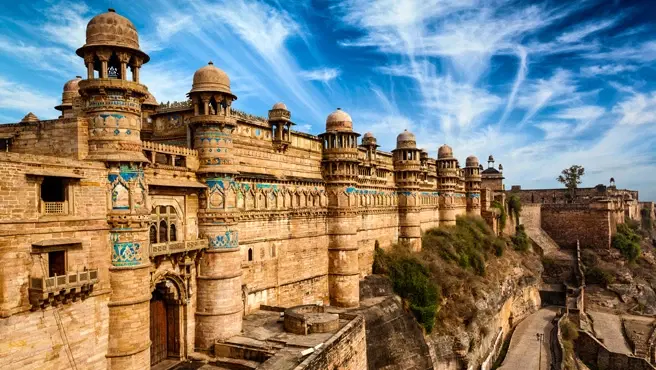
Hotels
•03 min read

Standing majestically near the confluence of the Ganges and Yamuna rivers, Akbar Fort Allahabad is a testament to the architectural brilliance and historical significance of the Mughal era. This blog provides a deep dive into the fascinating history, intricate design, and enduring cultural influence of this iconic monument. Readers will uncover the significance of its construction during Akbar's reign, explore its unique architectural features, and gather essential tips for planning their visit. Through an engaging exploration of history and architecture, this guide aims to inspire travel enthusiasts to connect with India's rich heritage.
Emperor Akbar designed the Allahabad Fort in 1583 to solidify the Mughal influence in an area that was not only strategically important but also rich in cultural heritage. Its location at the confluence of two major rivers played a crucial role in controlling trade routes and defense mechanisms, ensuring the consolidation of Mughal power. The fort even witnessed historical milestones such as the Treaty of Allahabad, underlining its pivotal role in India's history.
The fort has stood witness to remarkable events, including the revolt led by Prince Salim, which marked a turning point during Akbar's reign. Over the years, the fort also served different roles, transitioning into a period of conflict during the early days of British rule. Each phase in its history adds layers to its story, making it a living monument of Indian heritage.
Akbar Fort is celebrated for its masterful blend of Mughal and Persian architectural styles. Crafted with meticulous precision, the fort features unique elements such as the sacred Akshayavata tree and intriguing underground chambers. The design reflects an era when craftsmanship and grandeur were at the forefront of royal constructions, and it continues to inspire those who seek both luxury and historical depth.
Within the fort, visitors can admire splendid galleries, ancient temples, and breathtaking views of the Triveni Sangam where the millions of years of history seem to converge. Each structure within the fort grounds carries its own story, connecting travelers to the vibrant past of Allahabad. The experience is enriched by a palpable sense of cultural continuity that appeals to both history buffs and casual tourists alike.

Planning a visit to Akbar Fort can be both exciting and simple with the right tips. Although parts of the fort remain restricted due to security or military occupancy, there are ample areas accessible to the public where you can absorb the rich heritage firsthand. Essential details such as ticket prices, opening hours, and the best times to visit are available with local authorities to ensure a smooth experience. This thoughtful planning reflects how Tata Neu Travel simplifies and enriches the journey, making every trip memorable.
Apart from exploring the mighty fort, visitors will find a treasure trove of cultural and historical sites nearby. Destinations like Khusrau Bagh, Anand Bhavan, and the majestic All Saints Cathedral underscore the historical allure of Allahabad. These attractions provide a curated experience for history enthusiasts, allowing travelers to indulge in the city’s layered narrative while enjoying luxurious and comfortable travel experiences.
Did You Know? The Strategic Genius of Akbar
Akbar Fort was strategically built at the confluence of two major rivers, the Ganges and Yamuna, not only to showcase Mughal architectural brilliance but also to cement control over a region critical for trade and defense.
Akbar Fort stands shoulder-to-shoulder with other famed Mughal forts such as Agra Fort and Fatehpur Sikri. Yet, its distinct location in Allahabad and the blend of architectural styles set it apart. The fort encapsulates the essence of Mughal grandeur while uniquely reflecting the confluence of cultures that exist only in Allahabad, making it a truly unique landmark among ancient forts in India.
Today, Akbar Fort is preserved as a cultural treasure by the Archaeological Survey of India, symbolizing the state’s historical resilience and cultural pride. It plays a pivotal role in shaping the identity of Prayagraj (formerly Allahabad) and stands as an inspiring backdrop for those looking to explore the fusion of heritage and modern-day luxury, an aspiration that resonates with the Tata legacy of seamless travel and memorable experiences.

Akbar built the Allahabad Fort in 1583 to establish strategic control over the region and to display the grandeur of Mughal architecture.
The fort is partially open to visitors, but some areas remain restricted due to military occupancy. Check with local authorities for current access details.
Parts of the fort are closed to the public as they are under the control of the Indian Army for security reasons.
The Allahabad Fort, also known as Akbar Fort, was built by Mughal Emperor Akbar in 1583.
Akbar Fort Allahabad stands as a remarkable testament to India’s rich historical and architectural legacy. It not only illustrates the strategic foresight of Akbar but also mirrors the cultural evolution of a nation. Each stone of the fort narrates stories of a bygone era, inviting travelers to step into history and experience a world where the past and present meet in inspiring harmony. With detailed insights into its history, architectural prowess, and practical visitation tips, this guide is designed for every traveler seeking both enrichment and luxury in their journey. As you plan your visit, reflect on the significance of this Mughal marvel and embrace the seamless travel experiences that Tata Neu Travel offers, ensuring every trip is as enriching as the history it unveils.